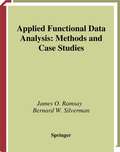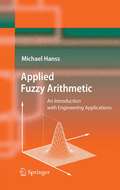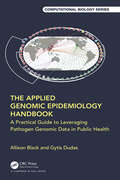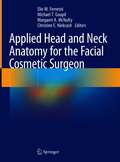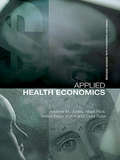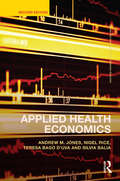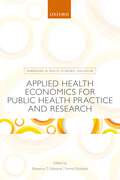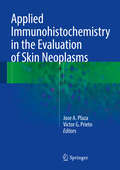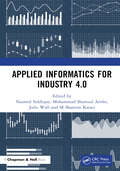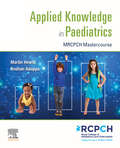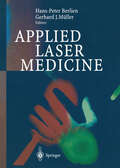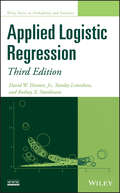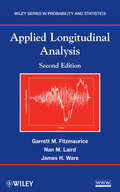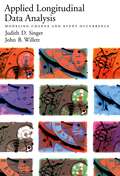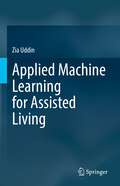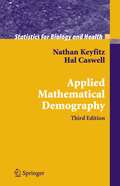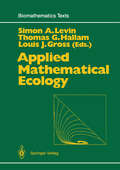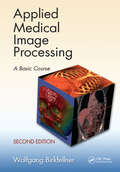- Table View
- List View
Applied Functional Data Analysis: Methods and Case Studies (Springer Series in Statistics)
by J.O. Ramsay B.W. SilvermanThis book contains the ideas of functional data analysis by a number of case studies. The case studies are accessible to research workers in a wide range of disciplines. Every reader should gain not only a specific understanding of the methods of functional data analysis, but more importantly a general insight into the underlying patterns of thought. There is an associated web site with MATLABr and S?PLUSr implementations of the methods discussed.
Applied Fuzzy Arithmetic: An Introduction with Engineering Applications
by Michael HanssFirst book that provides both theory and real world applications of fuzzy arithmetic in a comprehensive style. Provides a well-structured compendium that offers both a deeper knowledge about the theory of fuzzy arithmetic and an extensive view on its applications in the engineering sciences making it useful for graduate courses, researchers and engineers. Presents the basic definitions and fundamental principles of fuzzy arithmetic, derived from fuzzy set theory. Summarizes the state-of-the-art stage of fuzzy arithmetic, offers a comprehensive composition of different approaches including their benefits and drawbacks, and finally, and presents a completely new methodology of implementation of fuzzy arithmetic with particular emphasis on its subsequent application to real-world systems. Concentrates on the application of fuzzy arithmetic to the simulation, analysis and identification of systems with uncertain model parameters, as they appear in various disciplines of engineering science. Focuses on mechanical engineering, geotechnical engineering, biomedical engineering, and control engineering.
The Applied Genomic Epidemiology Handbook: A Practical Guide to Leveraging Pathogen Genomic Data in Public Health (Chapman & Hall/CRC Computational Biology Series)
by Allison Black Gytis DudasThe Applied Genomic Epidemiology Handbook: A Practical Guide to Leveraging Pathogen Genomic Data in Public Health provides rationale, theory, and implementation guidance to help public health practitioners incorporate pathogen genomic data analysis into their investigations. During the SARS-CoV-2 pandemic, viral whole genome sequences were generated, analyzed, and shared at an unprecedented scale. This wealth of data posed both tremendous opportunities and challenges; the data could be used to support varied parts of the public health response but could be hard for much of the public health workforce to analyze and interpret, given a historical lack of experience working with pathogen genomic data.This book addresses that gap. Structured into eight wide-ranging chapters, this book describes how the overlapping timescales of pathogen evolution and infection transmission enable exploration of epidemiologic dynamics from pathogen sequence data. Different approaches to sampling and genomic data inclusion are presented for different types of epidemiologic investigations. To support epidemiologists in diving into pathogen genomic data analysis, this book also introduces the analytic tools and approaches that are readily used in public health departments and presents case studies to show step-by-step how genomic data are used and evaluated in disease investigations.Despite the breadth of scientific literature that uses pathogen genomic data to investigate disease dynamics, there remains little practical guidance to help applied epidemiologists build their ability to explore epidemiologic questions with pathogen genomic data. This handbook was written to serve as that guide. Including case studies, common methods, and software tools, this book will be of great interest to public health microbiologists or lab directors, bioinformaticians, epidemiologists, health officers, academics, as well as students working in a public health context.
The Applied Genomic Epidemiology Handbook: A Practical Guide to Leveraging Pathogen Genomic Data in Public Health (Chapman & Hall/CRC Computational Biology Series)
by Allison Black Gytis DudasThe Applied Genomic Epidemiology Handbook: A Practical Guide to Leveraging Pathogen Genomic Data in Public Health provides rationale, theory, and implementation guidance to help public health practitioners incorporate pathogen genomic data analysis into their investigations. During the SARS-CoV-2 pandemic, viral whole genome sequences were generated, analyzed, and shared at an unprecedented scale. This wealth of data posed both tremendous opportunities and challenges; the data could be used to support varied parts of the public health response but could be hard for much of the public health workforce to analyze and interpret, given a historical lack of experience working with pathogen genomic data.This book addresses that gap. Structured into eight wide-ranging chapters, this book describes how the overlapping timescales of pathogen evolution and infection transmission enable exploration of epidemiologic dynamics from pathogen sequence data. Different approaches to sampling and genomic data inclusion are presented for different types of epidemiologic investigations. To support epidemiologists in diving into pathogen genomic data analysis, this book also introduces the analytic tools and approaches that are readily used in public health departments and presents case studies to show step-by-step how genomic data are used and evaluated in disease investigations.Despite the breadth of scientific literature that uses pathogen genomic data to investigate disease dynamics, there remains little practical guidance to help applied epidemiologists build their ability to explore epidemiologic questions with pathogen genomic data. This handbook was written to serve as that guide. Including case studies, common methods, and software tools, this book will be of great interest to public health microbiologists or lab directors, bioinformaticians, epidemiologists, health officers, academics, as well as students working in a public health context.
Applied Head and Neck Anatomy for the Facial Cosmetic Surgeon
by Elie M. Ferneini Michael T. Goupil Margaret A. McNulty Christine E. NiekrashThis multi-authored, multi-institutional, and multi-specialty based text is designed to inform and refresh practitioners who perform facial cosmetic surgery. Divided into three distinct sections for ease of use, the first section focuses exclusively on localized anesthesia for each region of the head and neck. Chapters focus on the techniques that best affect these regions with a chapter closing the first section, on managing potential anesthetic complications. The second section covers the regional anatomy of the face by offering high definition photos of cadaver dissections and anatomic illustrations to highlight pertinent muscle and bone structures. The third and final section combines the skills detailed in the first two sections and applies them to a variety of surgical, cosmetic procedures. In an era of high demand for aesthetic procedures, this text provides a practical and comprehensive look at facial cosmetic surgery to ensure practitioners have the best information available for treating their patients. The editors have extensive academic experience and have authored multiple scientific publications, while the contributions included in the text have been written by experts and leaders in the field. Applied Head and Neck Anatomy for the Facial Cosmetic Surgeon is written for a multi-disciplinary audience including oral & maxillofacial surgeons, plastic surgeons, otolaryngologists, cosmetic surgeons, and dentists.
Applied Health Economics
by Andrew M. Jones Nigel Rice Teresa Bago D'Uva Silvia BaliaLarge-scale survey datasets, in particular complex survey designs such as panel data, provide a rich source of information for health economists. They offer the scope to control for individual heterogeneity and to model the dynamics of individual behaviour. However the measures of outcome used in health economics are often qualitative or categorical. These create special problems for estimating econometric models. The dramatic growth in computing power over recent years has been accompanied by the development of methods that help to solve these problems. This book provides a practical guide to the skills required to put these techniques into practice. This book illustrates practical applications of these methods using data on health from, among others, the British Health and Lifestyle Survey (HALS), the British Household Panel Survey (BHPS), the European Community Household Panel (ECHP) and the WHO Multi-Country Survey (WHO-MCS). Assuming a familiarity with the basic syntax and structure of Stata, this book presents and explains the statistical output using empirical case studies rather than general theory. Never before has a health economics text brought theory and practice together and this book will be of great benefit to applied economists, as well as advanced undergraduate and post graduate students in health economics and applied econometrics.
Applied Health Economics
by Andrew M. Jones Nigel Rice Teresa Bago D'Uva Silvia BaliaThe first edition of Applied Health Economics did an expert job of showing how the availability of large scale data sets and the rapid advancement of advanced econometric techniques can help health economists and health professionals make sense of information better than ever before. This second edition has been revised and updated throughout and includes a new chapter on the description and modelling of individual health care costs, thus broadening the book’s readership to those working on risk adjustment and health technology appraisal. The text also fully reflects the very latest advances in the health economics field and the key journal literature. Large-scale survey datasets, in particular complex survey designs such as panel data, provide a rich source of information for health economists. They offer the scope to control for individual heterogeneity and to model the dynamics of individual behaviour. However, the measures of outcome used in health economics are often qualitative or categorical. These create special problems for estimating econometric models. The dramatic growth in computing power over recent years has been accompanied by the development of methods that help to solve these problems. The purpose of this book is to provide a practical guide to the skills required to put these techniques into practice. Practical applications of the methods are illustrated using data on health from the British Health and Lifestyle Survey (HALS), the British Household Panel Survey (BHPS), the European Community Household Panel (ECHP), the US Medical Expenditure Panel Survey (MEPS) and Survey of Health, Ageing and Retirement in Europe (SHARE). There is a strong emphasis on applied work, illustrating the use of relevant computer software with code provided for Stata. Familiarity with the basic syntax and structure of Stata is assumed. The Stata code and extracts from the statistical output are embedded directly in the main text and explained at regular intervals. The book is built around empirical case studies, rather than general theory, and the emphasis is on learning by example. It presents a detailed dissection of methods and results of some recent research papers written by the authors and their colleagues. Relevant methods are presented alongside the Stata code that can be used to implement them and the empirical results are discussed at each stage. This text brings together the theory and application of health economics and econometrics, and will be a valuable reference for applied economists and students of health economics and applied econometrics.
Applied Health Economics
by Andrew M. Jones Nigel Rice Teresa Bago D'Uva Silvia BaliaThe first edition of Applied Health Economics did an expert job of showing how the availability of large scale data sets and the rapid advancement of advanced econometric techniques can help health economists and health professionals make sense of information better than ever before. This second edition has been revised and updated throughout and includes a new chapter on the description and modelling of individual health care costs, thus broadening the book’s readership to those working on risk adjustment and health technology appraisal. The text also fully reflects the very latest advances in the health economics field and the key journal literature. Large-scale survey datasets, in particular complex survey designs such as panel data, provide a rich source of information for health economists. They offer the scope to control for individual heterogeneity and to model the dynamics of individual behaviour. However, the measures of outcome used in health economics are often qualitative or categorical. These create special problems for estimating econometric models. The dramatic growth in computing power over recent years has been accompanied by the development of methods that help to solve these problems. The purpose of this book is to provide a practical guide to the skills required to put these techniques into practice. Practical applications of the methods are illustrated using data on health from the British Health and Lifestyle Survey (HALS), the British Household Panel Survey (BHPS), the European Community Household Panel (ECHP), the US Medical Expenditure Panel Survey (MEPS) and Survey of Health, Ageing and Retirement in Europe (SHARE). There is a strong emphasis on applied work, illustrating the use of relevant computer software with code provided for Stata. Familiarity with the basic syntax and structure of Stata is assumed. The Stata code and extracts from the statistical output are embedded directly in the main text and explained at regular intervals. The book is built around empirical case studies, rather than general theory, and the emphasis is on learning by example. It presents a detailed dissection of methods and results of some recent research papers written by the authors and their colleagues. Relevant methods are presented alongside the Stata code that can be used to implement them and the empirical results are discussed at each stage. This text brings together the theory and application of health economics and econometrics, and will be a valuable reference for applied economists and students of health economics and applied econometrics.
Applied Health Economics (Routledge Advanced Texts in Economics and Finance)
by Andrew M. Jones Nigel Rice Teresa Bago D'Uva Silvia BaliaLarge-scale survey datasets, in particular complex survey designs such as panel data, provide a rich source of information for health economists. They offer the scope to control for individual heterogeneity and to model the dynamics of individual behaviour. However the measures of outcome used in health economics are often qualitative or categorical. These create special problems for estimating econometric models. The dramatic growth in computing power over recent years has been accompanied by the development of methods that help to solve these problems. This book provides a practical guide to the skills required to put these techniques into practice. This book illustrates practical applications of these methods using data on health from, among others, the British Health and Lifestyle Survey (HALS), the British Household Panel Survey (BHPS), the European Community Household Panel (ECHP) and the WHO Multi-Country Survey (WHO-MCS). Assuming a familiarity with the basic syntax and structure of Stata, this book presents and explains the statistical output using empirical case studies rather than general theory. Never before has a health economics text brought theory and practice together and this book will be of great benefit to applied economists, as well as advanced undergraduate and post graduate students in health economics and applied econometrics.
Applied Health Economics for Public Health Practice and Research (Handbooks in Health Economic Evaluation)
by Rhiannon T. Edwards and Emma McIntoshIn today's world of scare resources, determining the optimal allocation of funds to preventive health care interventions (PHIs) is a challenge. The upfront investments needed must be viewed as long term projects, the benefits of which we will experience in the future. The long term positive change to PHIs from economic investment can be seen across multiple sectors such as health care, education, employment and beyond. Applied Health Economics for Public Health Practice and Research is the fifth in the series of Handbooks in Health Economic Evaluation. It presents new research on health economics methodology and application to the evaluation of public health interventions. Looking at traditional as well as novel methods of economic evaluation, the book covers the history of economics of public health and the economic rationale for government investment in prevention. In addition, it looks at principles of health economics, evidence synthesis, key methods of economic evaluation with accompanying case studies, and much more. Looking to the future, Applied Health Economics for Public Health Practice and Research presents priorities for research in the field of public health economics. It acknowledges the role played by natural environment in promoting better health, and the place of genetics, environment and socioeconomic status in determining population health. Ideal for health economists, public health researchers, local government workers, health care professionals, and those responsible for health policy development. Applied Health Economics for Public Health Practice and Research is an important contribution to the economic discussion of public health and resource allocation.
Applied Health Economics for Public Health Practice and Research (Handbooks in Health Economic Evaluation)
In today's world of scare resources, determining the optimal allocation of funds to preventive health care interventions (PHIs) is a challenge. The upfront investments needed must be viewed as long term projects, the benefits of which we will experience in the future. The long term positive change to PHIs from economic investment can be seen across multiple sectors such as health care, education, employment and beyond. Applied Health Economics for Public Health Practice and Research is the fifth in the series of Handbooks in Health Economic Evaluation. It presents new research on health economics methodology and application to the evaluation of public health interventions. Looking at traditional as well as novel methods of economic evaluation, the book covers the history of economics of public health and the economic rationale for government investment in prevention. In addition, it looks at principles of health economics, evidence synthesis, key methods of economic evaluation with accompanying case studies, and much more. Looking to the future, Applied Health Economics for Public Health Practice and Research presents priorities for research in the field of public health economics. It acknowledges the role played by natural environment in promoting better health, and the place of genetics, environment and socioeconomic status in determining population health. Ideal for health economists, public health researchers, local government workers, health care professionals, and those responsible for health policy development. Applied Health Economics for Public Health Practice and Research is an important contribution to the economic discussion of public health and resource allocation.
Applied Immunohistochemistry in the Evaluation of Skin Neoplasms
by Jose A. Plaza Victor G. PrietoThis book provides a comprehensive, state-of-the-art account of the role of immunohistochemistry in the diagnosis of skin tumors, which is crucial given that overlapping histologic features and unusual morphologic changes can lead to considerable diagnostic uncertainty. The book reviews in detail the sensitivity and specificity of commonly available antibodies and their pattern of immunostaining. readers will learn when to order antibodies and how to interpret findings. In addition, prognostic markers are evaluated and emphasis placed on the pitfalls commonly encountered when evaluating these neoplasms. The text is complemented by a wealth of superb images. Helpful histograms and algorithms are included, and clear guidance is provided on the application and interpretation of less commonly used antibodies and immunostains. Applied Immunohistochemistry in the Evaluation of Skin Neoplasms will serve as an extremely valuable resource for practicing dermatopathologists and pathologists.
Applied Informatics for Industry 4.0
by Nazmul Siddique Mohammad Shamsul Arefin Julie Wall M Shamim KaiserApplied Informatics for Industry 4.0 combines the technologies of computer science and information science to assist in the management and processing of data to provide different types of services. Due to the adaptation of 4.0 IR-related technologies, applied informatics is playing a vital role in different sectors such as healthcare, complex system design and privacy-related issues. This book focuses on cutting edge research from the fields of informatics and complex industrial systems, and will cover topics including health informatics, bioinformatics, brain informatics, genomics and proteomics, data and network security and more. The text will appeal to beginners and advanced researchers in the fields of computer science, information sciences, electrical and electronic engineering and robotics.
Applied Informatics for Industry 4.0
by Nazmul Siddique Mohammad Shamsul Arefin Julie Wall M. Shamim KaiserApplied Informatics for Industry 4.0 combines the technologies of computer science and information science to assist in the management and processing of data to provide different types of services. Due to the adaptation of 4.0 IR-related technologies, applied informatics is playing a vital role in different sectors such as healthcare, complex system design and privacy-related issues. This book focuses on cutting edge research from the fields of informatics and complex industrial systems, and will cover topics including health informatics, bioinformatics, brain informatics, genomics and proteomics, data and network security and more. The text will appeal to beginners and advanced researchers in the fields of computer science, information sciences, electrical and electronic engineering and robotics.
Applied Knowledge in Paediatrics: : MRCPCH Mastercourse - E-Book
by Martin Hewitt Roshan AdappaThe essential guide to passing the MRCPCH Applied Knowledge in Practice (AKP) exam. Closely aligned to the Royal College of Paediatrics and Child Health (RCPCH) theory examination syllabus and also reflective of current UK practice. Applied Knowledge in Paediatrics will leave the reader with a sound knowledge of all the core topics relevant to paediatrics and child health. It will also provide a useful study aid for those undertaking the MRCPCH Applied Knowledge in Practice examination. The book covers how and why illnesses develop in children and young people, the appropriate investigations and treatment required, the urgency of implementation and the impact of the disease process on the child and their family. This comprehensive text is edited by Dr Martin Hewitt, a Senior Theory Examiner for the AKP examination, and Dr Roshan Adappa a Senior clinician and postgraduate trainer, with expert input from more than 60 paediatric specialists. 33 chapters provide comprehensive information of all areas of paediatric practice. Directly aligned to the Applied Knowledge in Practice syllabus and examination 50 sample questions along with answers and reasoning explaining each of the answer options Chapter on how to prepare for the RCPCH AKP examination Clinical scenarios in each chapter outlining difficult clinical problems and proposed management plans Clinical images to aid understanding Level of detail to support clinical practice of paediatricians with 12-18 months experience
Applied Laser Medicine
by Hans-Peter Berlien H. Breuer Gerhard J. Müller N. Krasner T. Okunata D. SlineyThis handbook is intended for the advanced specialist and for the practitioner interested in the application of lasers in medicine. It provides summaries of all available medical laser systems and their clinical use. The first part introduces basic laser physics, including laser-tissue interactions as well as technical equipment and particular techniques developed for medical use in connection with laser. The second part of the text covers all areas of laser application in medicine and has been written by senior specialists from different countries. The book includes about 300 line drawings, more than 100 high quality photographs, an extensive subject and author register, and an exhaustive list of references.
Applied Logistic Regression (Wiley Series in Probability and Statistics)
by David W. Hosmer Jr. Stanley Lemeshow Rodney X. SturdivantA new edition of the definitive guide to logistic regression modeling for health science and other applications This thoroughly expanded Third Edition provides an easily accessible introduction to the logistic regression (LR) model and highlights the power of this model by examining the relationship between a dichotomous outcome and a set of covariables. Applied Logistic Regression, Third Edition emphasizes applications in the health sciences and handpicks topics that best suit the use of modern statistical software. The book provides readers with state-of-the-art techniques for building, interpreting, and assessing the performance of LR models. New and updated features include: A chapter on the analysis of correlated outcome data A wealth of additional material for topics ranging from Bayesian methods to assessing model fit Rich data sets from real-world studies that demonstrate each method under discussion Detailed examples and interpretation of the presented results as well as exercises throughout Applied Logistic Regression, Third Edition is a must-have guide for professionals and researchers who need to model nominal or ordinal scaled outcome variables in public health, medicine, and the social sciences as well as a wide range of other fields and disciplines.
Applied Logistic Regression (Wiley Series in Probability and Statistics #398)
by Stanley Lemeshow David W. Hosmer Jr. Rodney X. SturdivantA new edition of the definitive guide to logistic regression modeling for health science and other applications This thoroughly expanded Third Edition provides an easily accessible introduction to the logistic regression (LR) model and highlights the power of this model by examining the relationship between a dichotomous outcome and a set of covariables. Applied Logistic Regression, Third Edition emphasizes applications in the health sciences and handpicks topics that best suit the use of modern statistical software. The book provides readers with state-of-the-art techniques for building, interpreting, and assessing the performance of LR models. New and updated features include: A chapter on the analysis of correlated outcome data A wealth of additional material for topics ranging from Bayesian methods to assessing model fit Rich data sets from real-world studies that demonstrate each method under discussion Detailed examples and interpretation of the presented results as well as exercises throughout Applied Logistic Regression, Third Edition is a must-have guide for professionals and researchers who need to model nominal or ordinal scaled outcome variables in public health, medicine, and the social sciences as well as a wide range of other fields and disciplines.
Applied Longitudinal Analysis (Wiley Series in Probability and Statistics #998)
by Garrett M. Fitzmaurice Nan M. Laird James H. WarePraise for the First Edition ". . . [this book] should be on the shelf of everyone interested in . . . longitudinal data analysis." —Journal of the American Statistical Association Features newly developed topics and applications of the analysis of longitudinal data Applied Longitudinal Analysis, Second Edition presents modern methods for analyzing data from longitudinal studies and now features the latest state-of-the-art techniques. The book emphasizes practical, rather than theoretical, aspects of methods for the analysis of diverse types of longitudinal data that can be applied across various fields of study, from the health and medical sciences to the social and behavioral sciences. The authors incorporate their extensive academic and research experience along with various updates that have been made in response to reader feedback. The Second Edition features six newly added chapters that explore topics currently evolving in the field, including: Fixed effects and mixed effects models Marginal models and generalized estimating equations Approximate methods for generalized linear mixed effects models Multiple imputation and inverse probability weighted methods Smoothing methods for longitudinal data Sample size and power Each chapter presents methods in the setting of applications to data sets drawn from the health sciences. New problem sets have been added to many chapters, and a related website features sample programs and computer output using SAS, Stata, and R, as well as data sets and supplemental slides to facilitate a complete understanding of the material. With its strong emphasis on multidisciplinary applications and the interpretation of results, Applied Longitudinal Analysis, Second Edition is an excellent book for courses on statistics in the health and medical sciences at the upper-undergraduate and graduate levels. The book also serves as a valuable reference for researchers and professionals in the medical, public health, and pharmaceutical fields as well as those in social and behavioral sciences who would like to learn more about analyzing longitudinal data.
Applied Longitudinal Data Analysis: Modeling Change and Event Occurrence
by Judith D. Singer John B. WillettChange is constant in everyday life. Infants crawl and then walk, children learn to read and write, teenagers mature in myriad ways, the elderly become frail and forgetful. Beyond these natural processes and events, external forces and interventions instigate and disrupt change: test scores may rise after a coaching course, drug abusers may remain abstinent after residential treatment. By charting changes over time and investigating whether and when events occur, researchers reveal the temporal rhythms of our lives. Applied Longitudinal Data Analysis is a much-needed professional book for empirical researchers and graduate students in the behavioral, social, and biomedical sciences. It offers the first accessible in-depth presentation of two of today's most popular statistical methods: multilevel models for individual change and hazard/survival models for event occurrence (in both discrete- and continuous-time). Using clear, concise prose and real data sets from published studies, the authors take you step by step through complete analyses, from simple exploratory displays that reveal underlying patterns through sophisticated specifications of complex statistical models. Applied Longitudinal Data Analysis offers readers a private consultation session with internationally recognized experts and represents a unique contribution to the literature on quantitative empirical methods. Visit http://www.ats.ucla.edu/stat/examples/alda.htm for: · Downloadable data sets · Library of computer programs in SAS, SPSS, Stata, HLM, MLwiN, and more · Additional material for data analysis
Applied Longitudinal Data Analysis: Modeling Change and Event Occurrence
by Judith D. Singer John B. WillettChange is constant in everyday life. Infants crawl and then walk, children learn to read and write, teenagers mature in myriad ways, the elderly become frail and forgetful. Beyond these natural processes and events, external forces and interventions instigate and disrupt change: test scores may rise after a coaching course, drug abusers may remain abstinent after residential treatment. By charting changes over time and investigating whether and when events occur, researchers reveal the temporal rhythms of our lives. Applied Longitudinal Data Analysis is a much-needed professional book for empirical researchers and graduate students in the behavioral, social, and biomedical sciences. It offers the first accessible in-depth presentation of two of today's most popular statistical methods: multilevel models for individual change and hazard/survival models for event occurrence (in both discrete- and continuous-time). Using clear, concise prose and real data sets from published studies, the authors take you step by step through complete analyses, from simple exploratory displays that reveal underlying patterns through sophisticated specifications of complex statistical models. Applied Longitudinal Data Analysis offers readers a private consultation session with internationally recognized experts and represents a unique contribution to the literature on quantitative empirical methods. Visit http://www.ats.ucla.edu/stat/examples/alda.htm for: · Downloadable data sets · Library of computer programs in SAS, SPSS, Stata, HLM, MLwiN, and more · Additional material for data analysis
Applied Machine Learning for Assisted Living
by Zia UddinUser care at home is a matter of great concern since unforeseen circumstances might occur that affect people's well-being. Technologies that assist people in independent living are essential for enhancing care in a cost-effective and reliable manner. Assisted care applications often demand real-time observation of the environment and the resident’s activities using an event-driven system. As an emerging area of research and development, it is necessary to explore the approaches of the user care system in the literature to identify current practices for future research directions. Therefore, this book is aimed at a comprehensive review of data sources (e.g., sensors) with machine learning for various smart user care systems. To encourage the readers in the field, insights of practical essence of different machine learning algorithms with sensor data (e.g., publicly available datasets) are also discussed. Some code segments are also included to motivate the researchers of the related fields to practically implement the features and machine learning techniques. It is an effort to obtain knowledge of different types of sensor-based user monitoring technologies in-home environments. With the aim of adopting these technologies, research works, and their outcomes are reported. Besides, up to date references are included for the user monitoring technologies with the aim of facilitating independent living.Research that is related to the use of user monitoring technologies in assisted living is very widespread, but it is still consists mostly of limited-scale studies. Hence, user monitoring technology is a very promising field, especially for long-term care. However, monitoring of the users for smart assisted technologies should be taken to the next level with more detailed studies that evaluate and demonstrate their potential to contribute to prolonging the independent living of people. The target of this book is to contribute towards that direction.
Applied Mathematical Ecology (Biomathematics #18)
The Second Autumn Course on Mathematical Ecology was held at the Intern ational Centre for Theoretical Physics in Trieste, Italy in November and December of 1986. During the four year period that had elapsed since the First Autumn Course on Mathematical Ecology, sufficient progress had been made in applied mathemat ical ecology to merit tilting the balance maintained between theoretical aspects and applications in the 1982 Course toward applications. The course format, while similar to that of the first Autumn Course on Mathematical Ecology, consequently focused upon applications of mathematical ecology. Current areas of application are almost as diverse as the spectrum covered by ecology. The topiys of this book reflect this diversity and were chosen because of perceived interest and utility to developing countries. Topical lectures began with foundational material mostly derived from Math ematical Ecology: An Introduction (a compilation of the lectures of the 1982 course published by Springer-Verlag in this series, Volume 17) and, when possible, progressed to the frontiers of research. In addition to the course lectures, workshops were arranged for small groups to supplement and enhance the learning experience. Other perspectives were provided through presentations by course participants and speakers at the associated Research Conference. Many of the research papers are in a companion volume, Mathematical Ecology: Proceedings Trieste 1986, published by World Scientific Press in 1988. This book is structured primarily by application area. Part II provides an introduction to mathematical and statistical applications in resource management.
Applied Medical Image Processing: A Basic Course
by Wolfgang BirkfellnerA widely used, classroom-tested text, Applied Medical Image Processing: A Basic Course delivers an ideal introduction to image processing in medicine, emphasizing the clinical relevance and special requirements of the field. Avoiding excessive mathematical formalisms, the book presents key principles by implementing algorithms from scratch and usin
